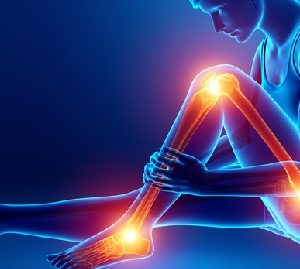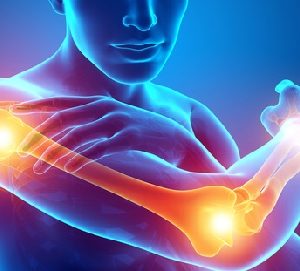Why Do I have Joint Pain? What Can I Do?
Understanding Joint Pain is the First Step to Reducing it
Understanding the anatomy and function of the body’s joints can help you begin to realize why you experience joint pain and what can be done to relieve it.
We tend to have a love-hate relationship with our joints. We love what they allow us to do when they’re healthy because let’s face it, working out in the gym, competing in a sporting event or even running after a toddler would be tough without strong, capable knees, shoulders and hips. The moment we start to experience joint pain, the relationship turns sour. The very joints that used to afford us so much strength and mobility suddenly become the source of constant irritation and chronic discomfort.
When you begin experiencing problems with one or more of your joints, you may wonder “Why do I have joint pain in the first place?” Sometimes it comes out of nowhere, creeping up on you with no warning or it can be a gradual onset of mild pain with muscle stiffness that increases to intolerable levels. Initially, joint pain can be easy to ignore but eventually, you need to take action to help alleviate your pain.
What is the Anatomy of a Joint?
Joints are defined as the places in the body where two or more bones meet. Joints are made up of several key components including cartilage, synovial membrane, ligaments, tendons and bursae.
Cartilage is a firm tissue that covers the surface of the bone in the joints. Its function is to act as a shock absorber, cushioning bones against colliding with one another during weight-bearing activity.
The synovial membrane is tissue that lines the joint and seals it into a joint capsule. Its function is to secrete synovial fluid which is a clear sticky fluid that lubricates the joint.
Ligaments are tough but flexible short bands of fibrous connective tissue that joins two bones together. Their function is to give support to the joint while limiting the range of motion.
Tendons are also a type of tough connective tissue that connects muscles to bones. Their function is to control the movement of the joint.
Bursae are fluid-filled sacs that nestle between the bones, ligaments, or other nearby structures. Their function is to help cushion the friction in a joint.
Joints are structurally complex with many different moving parts that can become inflamed, torn or otherwise injured due to a variety of reasons. Keeping them strong with an appropriate exercise routine that has been developed by a certified personal trainer is imperative for everyone from professional athletes to everyday people that are going through the normal aging process. It is also extremely important to support your joints with high-quality supplements that feed all of the different parts of the structure.
Why Do My Joints Hurt?
All of these components come together and are what allow the pivot, hinge, or ball-and-socket joints to move freely without pain or stiffness. When one or more of these components are compromised it means bone on bone contact can occur and that can produce extreme pain.
Once bone on bone occurs the result can be one of the leading causes of disability in North America – arthritis. When you have severe joint pain that occurs for extended periods of time, you need to check with your physician whether you have a chronic degenerative joint disease such as arthritis or a more acute injury that may require further treatment. Remember, any time you are experiencing pain and inflammation it’s your body’s alert system telling you that there is something wrong. Simply masking that pain with anti-inflammatories or other analgesics can lead to more damage to the joint.
There are other potential reasons for joint pain so make sure you don’t try to self-diagnose. Other potential causes of joint pain include, but aren’t limited to, viral infection, a strep infection, Lyme disease, or Gout. It is also possible that you have a condition that doesn’t technically exist inside the joint, but causes pain in or around the joint. Conditions matching this situation would include Osteoporosis, Fibromyalgia, Bursitis and Tendonitis. The last two are often caused by injury. All of these issues will require you see your doctor so she/he can provide you with the correct medication or send you to the proper health professional for treatment.
How Can You Improve Joint Health?
Preventing chronic pain due to joint mobility issues starts at home by providing your body with the correct vitamins, minerals, amino acids, and botanicals that stimulate the repair of the damaged tissue as well as the growth of new tissue.
Some of the key nutrients to incorporate into your daily supplement regime should include: Zinc, a Vitamin B complex, Copper and Glucosamine sulfate, Chondroitin and MSM (Methylsulfonylmethane)
Zinc is an important mineral supporting several processes in the body including the production of cells that stimulate the growth of joint cartilage [1].
A vitamin B complex is needed because of its powerful antioxidants and nutrients that target nerves in the joints that can contribute to persistent pain. It also increases blood flow to the affected joints, which reduces swelling and inflammation while enhancing the recovery process [1, 2].
Copper aids in building red blood cells by transporting iron; helps make connective tissue; helps keep the immune system, nerves and blood vessels healthy; and serves as an antioxidant by removing free radicals.
Glucosamine is produced naturally in your body. It plays a major role in joint health as it helps build and repair cartilage that connects the joints [4].
Chondroitin is a major component of cartilage, which helps cushion your joints and prevent your bones from rubbing against each other [5, 6].
MSM is a sulphur-containing compound that helps support tendons and muscles. MSM helps with pain relief and has anti-inflammatory characteristics [7]
All of the above-mentioned nutrients provide your body with powerful antioxidants that prevent the inflammatory process and harmful toxins from creating or increasing joint damage [1, 2]. Some other nutrients to consider would be amino acids, Boron and L-Histidine because they stimulate the release of collagen, a protein that builds strong cartilage and bone.
Whatever the case, if you’ve reached a point where you need some answers, we have them for you. Infofit will try to help you better understand not only the anatomy of your joints but some of the possible causes that may be contributing to your pain. Nutrition can also play an important role in managing and preventing joint pain. If you want more information on how nutrition can help reduce joint pain see Infofit’s sports nutrition course. Learn how to use food and supplements to reduce inflammation, optimize body composition and reduce body fat and so much more.
And, once you have been assessed by your physiotherapist or physician and are ready to start, come in, and work with one of our clinical exercise specialists. Our team of elite certified personal trainers have extensive experience in strengthening the muscles and connective tissue around your affected joint(s).
Start living again! Your joints shouldn’t be stopping you from living the life you want to live!
Happy Training!
References
- Mehra P, Wolford LM. Serum nutrient deficiencies in the patient with complex temporomandibular joint problems. Proc (Bayl Univ Med Cent). 2008; 21(3):243-7.
- Dehghan M. Comparative effectiveness of B and e vitamins with diclofenac in reducing pain due to osteoarthritis of the knee. Med Arch. 2015; 69(2):103-6.
- Yazar M, Sarban S, Kocyigit A, Isikan UE. Synovial fluid and plasma selenium, copper, zinc, and iron concentrations in patients with rheumatoid arthritis and osteoarthritis. Biol Trace Elem Res. 2005; 106(2):123-32.
- Pavelka K, Gatterova J, Olejarova M, Machacek S, Giacovelli G, Rovati LC: Glucosamine sulfate use and delay of progression of knee osteoarthritis: a 3-year, randomized, placebo-controlled, double-blind study. Arch Intern Med. 2002; 162: 2113-2123.
- Black C, Clar C, Henderson R, MacEachern C, McNamee P, Quayyum Z, Royle P, Thomas S: The clinical effectiveness of glucosamine and chondroitin supplements in slowing or arresting progression of osteoarthritis of the knee: a systematic review and economic evaluation. Health Technol Assess. 2009; 13: 1-148.
- Hochberg MC, Martel-Pelletier J, Monfort J, et al. Combined chondroitin sulfate and glucosamine for painful knee osteoarthritis: a multicentre, randomised, double-blind, non-inferiority trial versus celecoxib. Ann Rheum Dis. 2016; 75(1):37-44.
- Magrans-Courtney T, Wilborn C, Rasmussen C, Ferreira M, Greenwood L, Campbell B, Kerksick CM, Nassar E, Li R, Iosia M, Cooke M, Dugan K, Willoughby D, Soliah L, Kreider RB. Effects of diet type and supplementation of glucosamine, chondroitin, and MSM on body composition, functional status, and markers of health in women with knee osteoarthritis initiating a resistance-based exercise and weight loss program. J Int Soc Sports Nutr. 2011; 8(1)
- Bassarello C, Bifulco G, Montoro P, Skhirtladze A, Benidze M, Kemertelidze E, Pizza C, Piacente S. Yucca gloriosa: a source of phenolic derivatives with strong antioxidant activity. J Agric Food Chem. 2007; 55(16):6636-42.
- Warnock M, McBean D, Suter A, Tan J, Whittaker P. Effectiveness and safety of Devil’s Claw tablets in patients with general rheumatic disorders. Phytother Res. 2007; 21(12):1228-33.
- Institute of Medicine, Food and Nutrition Board. (2001). Dietary Reference Intakes for Vitamin A, Vitamin K, Arsenic, Boron, Chromium, Copper, Iodine, Iron, Manganese, Molybdenum, Nickel, Silicon, Vanadium, and Zinc. Washington, DC: National Academy Press.
- Mickleborough TD, Sinex JA, Platt D, Chapman RF, Hirt M. The effects PCSO-524®, a patented marine oil lipid and omega-3 PUFA blend derived from the New Zealand green lipped mussel (Perna canaliculus), on indirect markers of muscle damage and inflammation after muscle damaging exercise in untrained men: a randomized, placebo controlled trial. J Int Soc Sports Nutr. 2015;12:10.
- https://www.arthritis.org/living-with-arthritis/treatments/natural/vitamins-minerals/guide/copper.php
-
 Exercise Rehab: Hip, Knee, Ankle$288.75 – $519.75
Exercise Rehab: Hip, Knee, Ankle$288.75 – $519.75 -
 Exercise Rehabilitation: Shoulder, Elbow, Wrist$288.75 – $519.75
Exercise Rehabilitation: Shoulder, Elbow, Wrist$288.75 – $519.75

